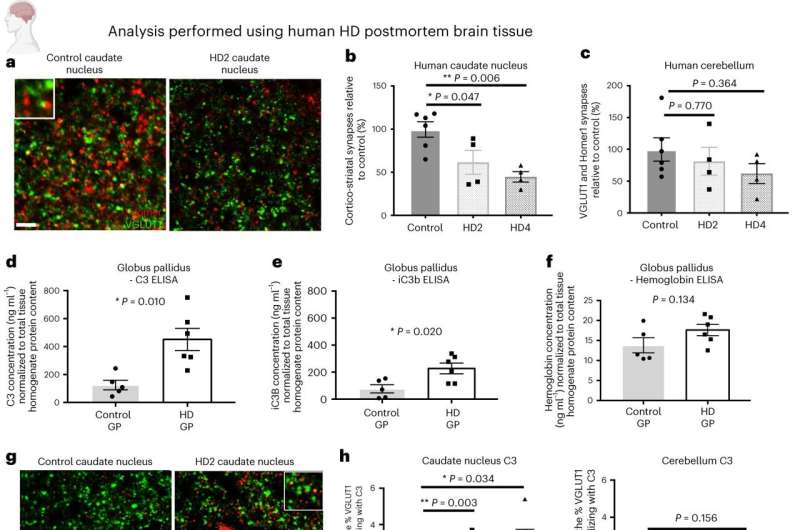This article has been reviewed according to Science X's editorial process and policies. Editors have highlighted the following attributes while ensuring the content's credibility:
fact-checked
peer-reviewed publication
trusted source
proofread
A step towards understanding early interventions for Huntington's disease

Huntington's disease is the most common neurodegenerative disorder controlled by a single gene and is characterized by motor and cognitive deficits and psychiatric symptoms. Currently, no treatments can stop or reverse the disease, but new research from Boston Children's Hospital suggests that there might be a way to protect the brain and prevent or slow cognitive decline.
Research from the lab of Beth Stevens, Ph.D. suggests that parts of the immune system—complement proteins and microglia—mediate the loss of specific synapses connecting the brain's cortex and striatum. The findings, recently published in Nature Medicine, could also shed light on other neurodegenerative conditions like Alzheimer's Disease.
In 2012, the Stevens lab was one of the first to show that microglia engulf and prune synapses during normal brain development, fine-tuning the brain's connections. The lab also showed that complement proteins tag synapses meant for elimination. Stevens and her team speculated that in diseases involving synapse loss, like Alzheimer's Disease, schizophrenia, and Huntington's disease, this pruning process is abnormally reactivated.
Huntington's disease offered an ideal opportunity to test their theory, both because there is a single gene associated with the condition and because it has a very well-defined pathology with specific brain regions and even select synaptic connections between neurons being impacted at early stages of the disease.
Using an animal model and postmortem brain samples from patients with Huntington's disease, Stevens and colleagues showed that complement proteins and microglia are activated very early in the illness—before cognitive and motor symptoms emerge—and that they target a specific vulnerable brain circuit in the pathway connecting the cortex and striatum.
Corticostriatal circuits are known to be involved in movement and learning what actions lead to positive outcomes or "reward." The researchers saw increased levels of complement proteins, specifically around these synapses in the striatum. At the same time, inputs from neurons in other brain regions that connect to the same cells were relatively spared.

When the team blocked the complement protein C1q in their animal model—either with an antibody or by genetically deleting the complement receptor CR3 on microglia—they prevented synapse loss. They also prevented cognitive defects around visual discrimination learning and cognitive flexibility.
"Some cognitive deficits tend to develop much earlier than motor defects in Huntington's disease, and this occurs in humans, too," notes Dan Wilton, Ph.D., first author of the study. "The Huntington's disease model we are studying does develop some slight motor defects that are also resolved with complement blocking strategies."
Wilton and colleagues showed a mechanism of specificity, selective vulnerability, and what happens at the earliest stages of Huntington's disease. The findings also suggest a possible biomarker: levels of innate immune molecules were elevated in the cerebrospinal fluid (CSF) of patients with Huntington's disease, even before the appearance of motor symptoms correlating with a known predictor of pathological severity and disease onset.
"We're excited by the idea that we could identify neuroimmune biomarkers to stratify people at the earliest stage and prioritize some for treatment," says Stevens, a member of the F.M. Kirby Neurobiology Center at Boston Children's and affiliate with the Broad Institute and Howard Hughes Medical Institute. "If you had clinical samples such as CSF, measuring these biomarkers could bring insight into what is happening in the brain."
Stevens thinks similar mechanisms and biomarkers may apply to other neurodegenerative disorders, such as Alzheimer's and frontotemporal dementia, which her lab is also exploring.
But most immediately, Stevens' team hopes to unravel how the huntingtin mutation leads to complement activation. They know that specific expression of mutant huntingtin in both cortical and striatal neurons is required to initiate the synaptic elimination mechanism. Still, the factors leading to the selective targeting of corticostriatal inputs remain to be determined.
"Huntington's is a nice model to tease this out," says Stevens. "That's a major future direction for our group.
More information: Daniel K. Wilton et al, Microglia and complement mediate early corticostriatal synapse loss and cognitive dysfunction in Huntington's disease, Nature Medicine (2023). DOI: 10.1038/s41591-023-02566-3




















